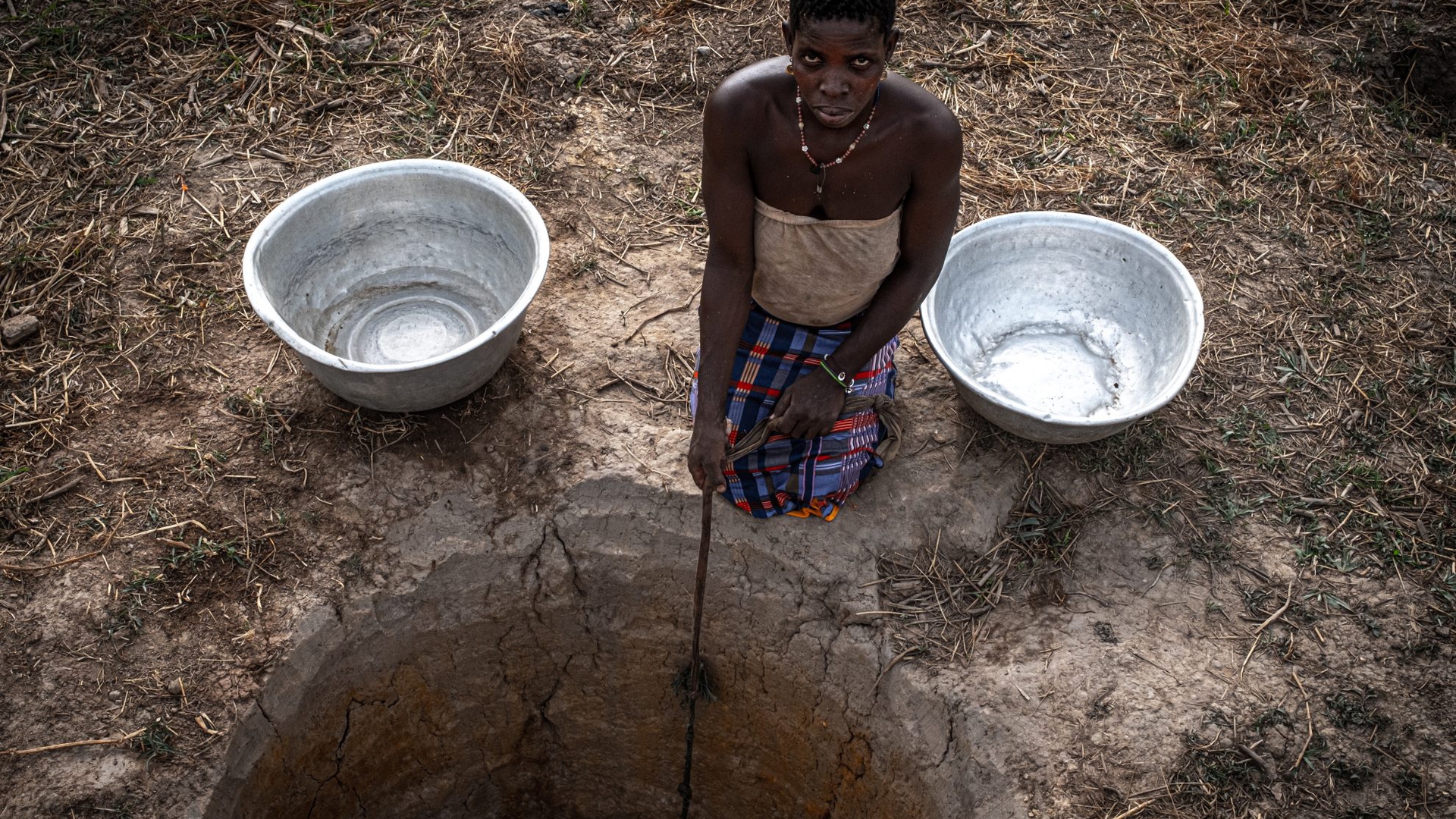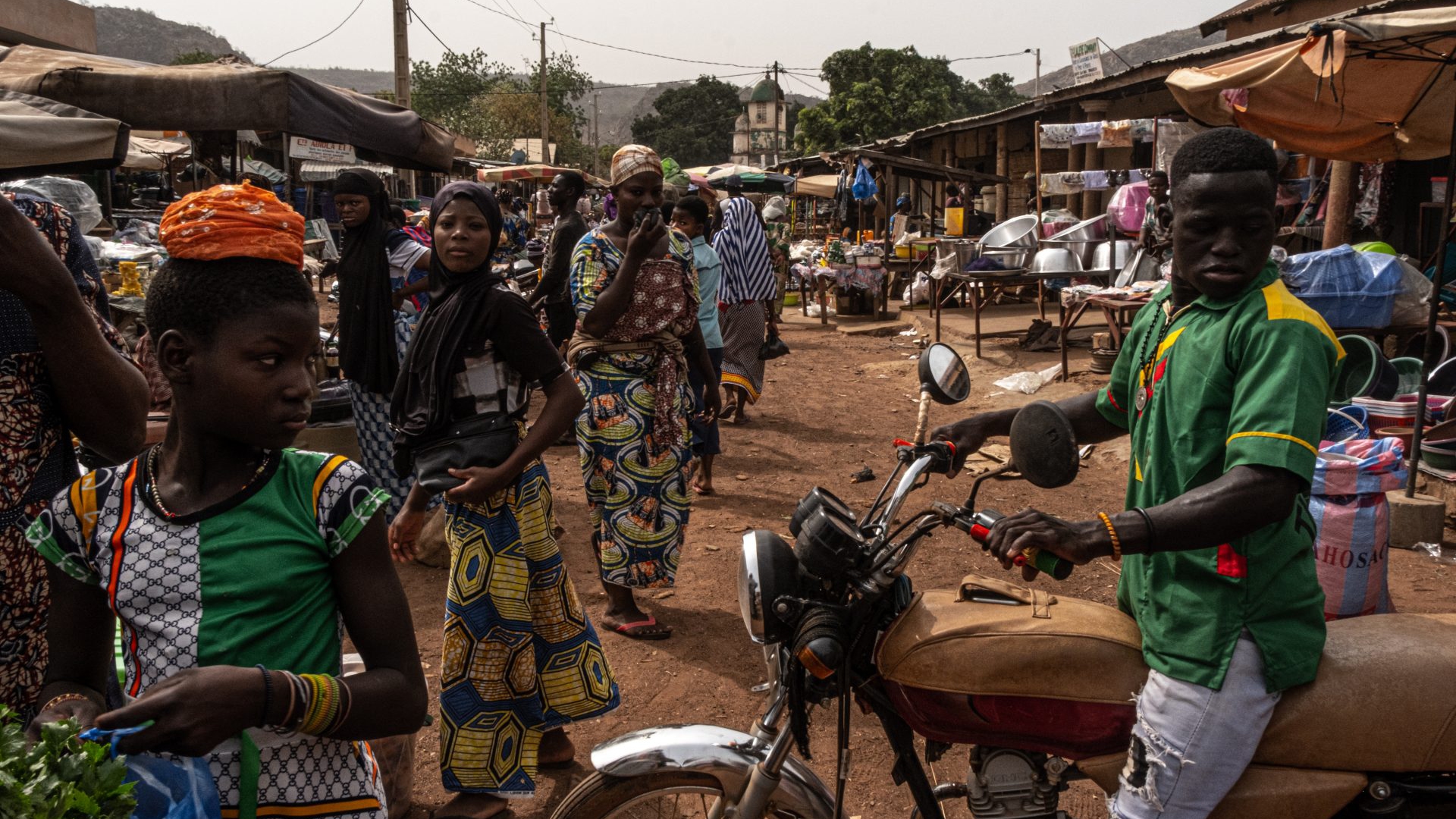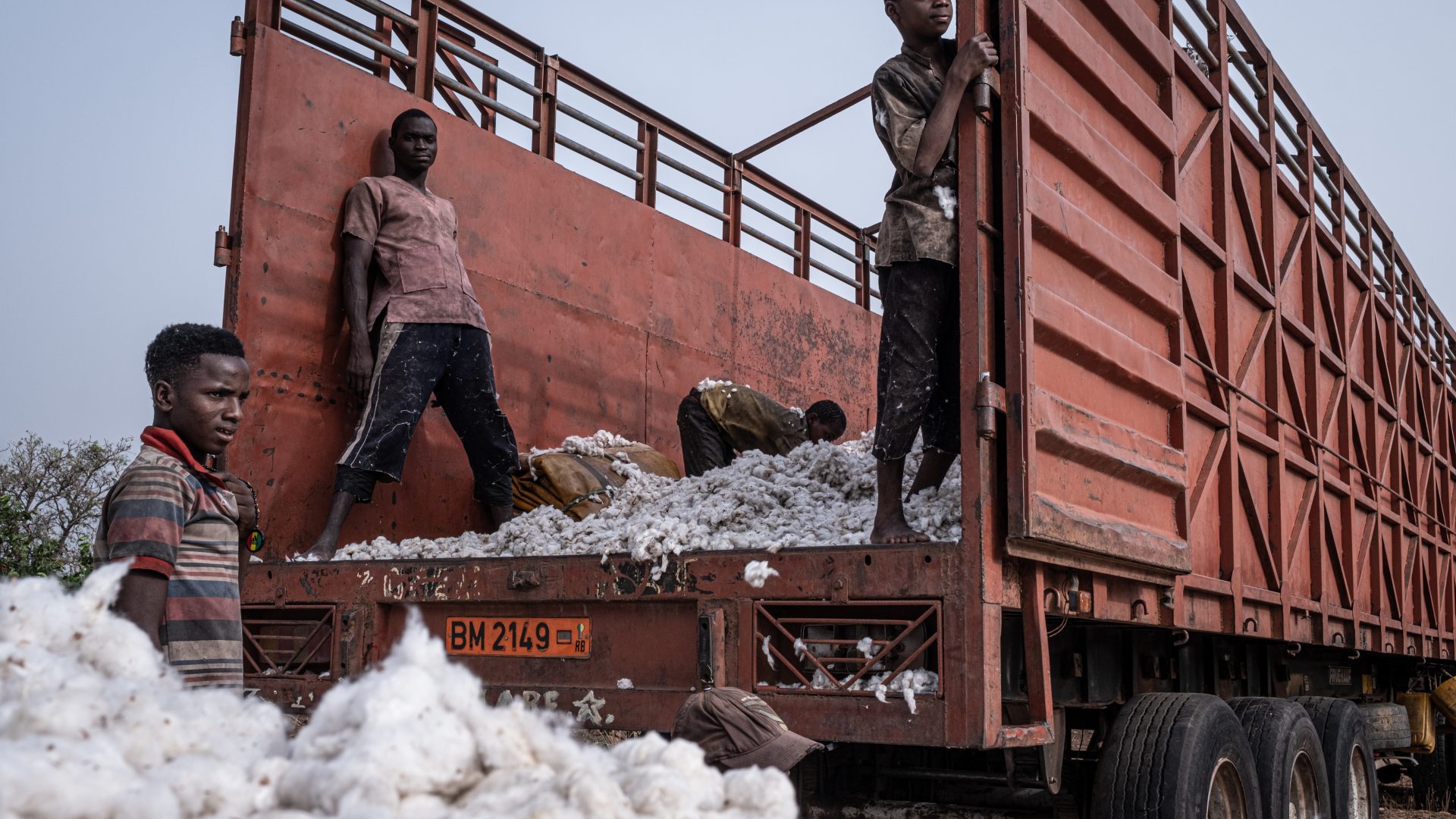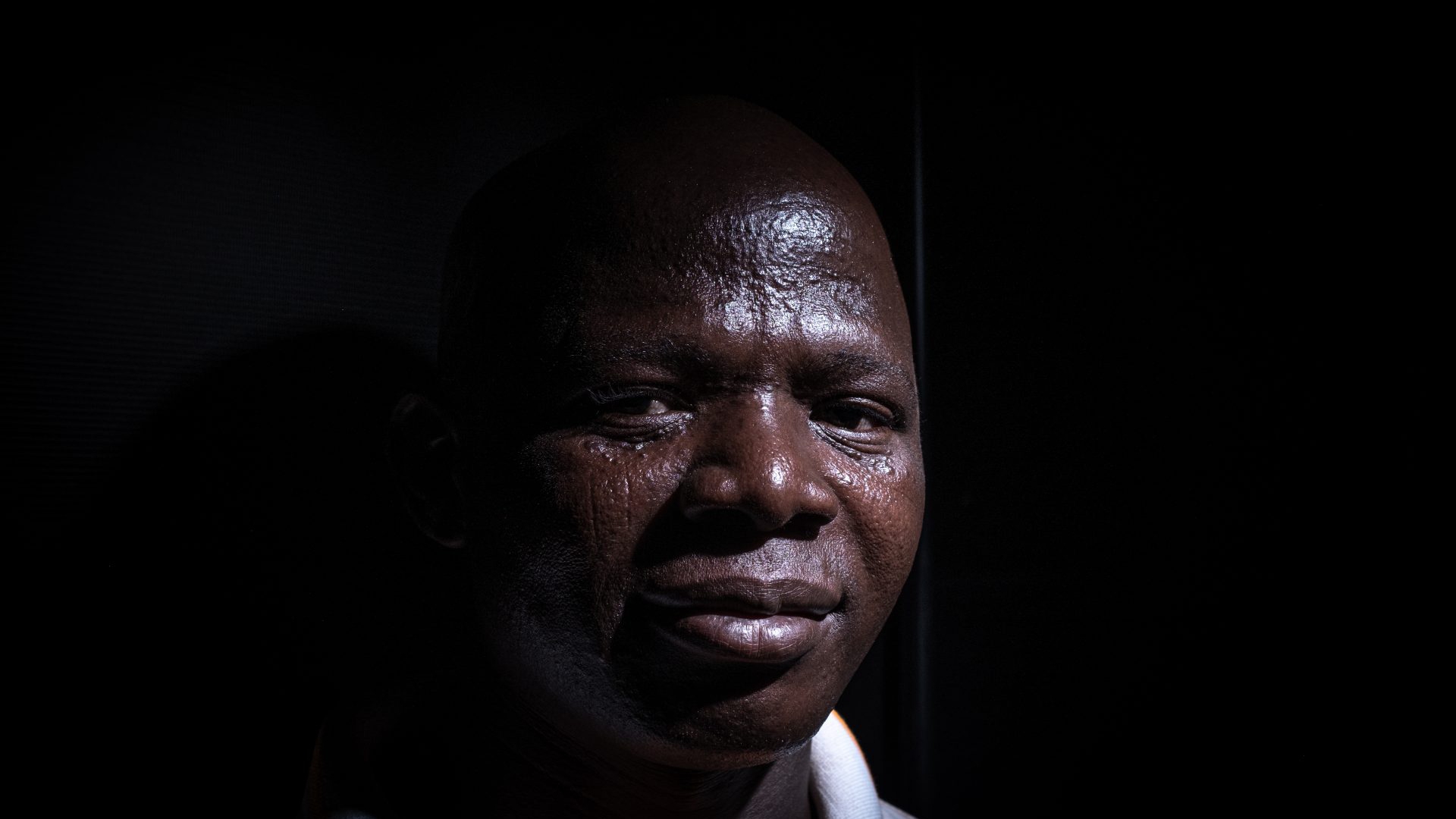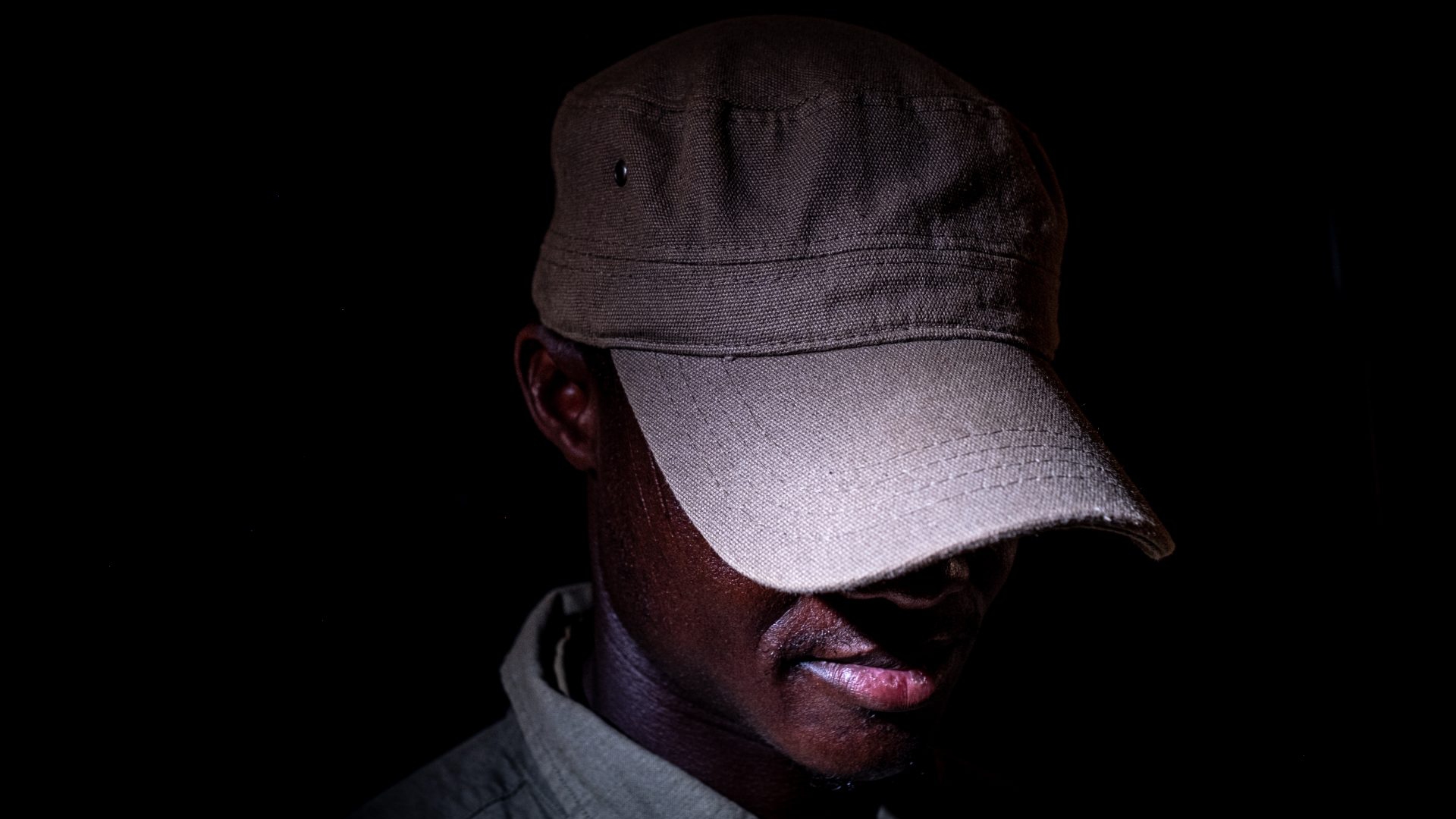
Benin is the new jihadist front in Africa
Islamic fundamentalism continues to destabilise the Sahel and now seems to be targeting the northern borders of West African countries. Northern Benin is at the centre of an escalation of attacks and risks being overwhelmed, as the climate crisis foments resentment.
Reading time: 30 min.
This project has been co-funded by the Pulitzer Center
When Kadri Sambieni Issa drives along Route Nationale 3, from the small town of Tanguiéta to the neighbouring border with Burkina Faso, he is struck by a great sense of nostalgia. His open jeep speeds along this red stretch of land that runs through many small villages in the Atakora department and skirts the immense Pendjari Park, one of the most important nature reserves in Benin and the region.
There was a time when, looking in the rear-view mirror, he would have seen Western tourists sitting on the seats of his safari jeep intent on observing the landscape with cameras and binoculars. However, those seats are now empty.
The landscape has also changed a lot. Trees and vegetation have diminished, giving way to barren land and extensive cotton and soya fields which occasionally are crossed by herds of Zebu.
Kadri is a Beninese guide who has accompanied visitors into the Pendjari wilderness for 12 years. “I was born in Tanougou, near the famous waterfalls in the buffer zone of the reserve. When I was a child I was already a guide at the waterfalls. Tourists would come and we accompanied them morning and afternoon. I was born for this job because I love nature. I love lions and elephants.”
Everything changed in May 2019 when two French tourists were kidnapped by jihadist militiamen inside the park and their guide, Fiacre Gbédji, was killed in the ambush. “I knew Fiacre. He was experienced and smart and taught me a lot. It was a loss for us and for his family. After those events, the tourists slowly disappeared. Today we can no longer approach the border and the park is closed. Only the military forces and rangers can enter”.
Almost without realising it, Benin found itself on the list of countries threatened by terrorism. After that attack, others followed in the northern regions bordering Burkina Faso, Niger and Nigeria, and the Porto-Novo government reacted by militarising the area in an attempt to flush out extremist cells.
In the Atakora department alone, one of the least developed in the country, more than 100 tour guides were employed. Hundreds more worked in the various small hotels that had begun to create income by collaborating with communities in neighbouring villages. Now it is all in limbo and Kadri, like all other members of the Union de Guides transporteurs des touristes de la Pendjari (UGTP), is currently unemployed and has to make ends meet by doing other things.
“Because almost all of us have a driver’s licence, most of us have taken up taxi driving or transporting goods between villages and markets,” he says despondently. “Before, we did not feel the threat much, we saw it far away and were not afraid. We didn’t think it could happen. It could have been a prosperous paradise and instead I wonder what will become of this land of ours.”
It could have been a prosperous paradise and instead I wonder what will become of this land of ours.
Kadri, Beninese guide

The Sahelian conflict is slow and wearisome. It tears apart entire countries and shatters century-old socio-cultural balances. Jihadist extremism has been plaguing this region for more than ten years and, after causing serious humanitarian emergencies with more than 5 million displaced persons, it is increasingly foreshadowing the start of an irreversible crisis. Acts of violence linked to Islamic extremist groups in Burkina Faso, Mali and Niger increased by 70 per cent in 2021, as evidenced by data from the Armed Conflict Location & Event Data Project (ACLED). Due to changes in Mali, which is controlled by an authoritarian military junta and from which France and the EU are withdrawing, leaving space for Russian contractors, the actions of jihadist groups have moved to Burkina Faso. More than half of the jihadist attacks have taken place in this country and last January a coup d’état brought a military junta with an unstable government to power.
At the same time, a new phase of the crisis is opening up. Major Sahelian jihadist cartels such as the Islam and Muslim Support Group (GSIM) and the Islamic State in the Greater Sahara (ISGS) are trying to expand into the border areas of the West African coastal states.
The escalation of border attacks that in recent years has hit Côte d’Ivoire, Togo and especially Benin in quick succession is clear proof of this and could be part of a broad regional repositioning strategy. This is also confirmed by international analysts from the Institute for Security Studies (ISS) and the African centre for strategic studies.
The extremists’ objectives are to promote the recruitment of militiamen in these areas and, above all, to secure the passage routes of illegal trafficking from the Atlantic coast to the Sahara, with which the terrorists finance themselves.
“In these cross-border areas, we are confronted with ‘bridges’ between different criminal identities. There are passeurs and traffickers of all kinds, and the kidnapping industry in north-west Nigeria bordering Benin is certainly not negligible either,” stresses Oswald Padonou, a professor in Beninese strategic and security studies.
Acts of violence linked to Islamic extremist groups in conflict-affected Sahelian areas increased by 70 per cent in 2021.
Armed Conflict Location & Event Data Project (ACLED)
Poaching, drugs, motorbikes, fuel, human beings, weapons, gold and precious wood are indeed the lifeblood of the cartels and therefore “the jihadist strategy must be sought there,” says Padanou, who believes the problem was initially underestimated. “People only thought about the transit of jihadists in border areas. Today, however, we are talking about micro-cells and recruitment in the north of Benin and therefore about the ‘endogenisation’ of the Islamic extremist phenomenon, which has gradually found space in the most marginalised areas”. This phenomenon has been smouldering for some time and its consequences are starting to become apparent.
The town of Porga on the border with Burkina Faso is an example of this. Here, since December, the security forces have been attacked three times by extremists affiliated with the jihadist GSIM cartel, with these ambushes and IED attacks claiming several lives among the military. Now the population lives in uncertainty in a dystopian setting where time seems to stand still.
There are several reasons why Benin, and particularly its northern regions, represent the perfect context for the new jihadist advance. The Beninese security forces do not seem sufficiently organised and equipped to respond to the threat, so much so that last May, President Patrice Talon announced the repatriation of forces deployed in the peacekeeping mission in Mali, MINUSMA, to try to reinforce its threatened borders. Moreover, last July, his government announced a military cooperation agreement with the better-equipped Niger military forces in the hope of restricting incursions, and requested further support during the recent visit of French President Macron.
The permeability of these areas has made the W-Arly-Pendjari (WAP) nature reserve complex of key importance because it covers an area of over 32,000 square kilometres straddling Bénin, Burkina and Niger. These are inaccessible regions covered with forests and rocky hillsides that are difficult to cover and far from the main roads. “Within the parks, extremist militiamen can find safe refuge, but also train and act almost undisturbed, especially in the management of their trafficking,” explains Professor Padanou.
Benin is also strategically attractive to these cartels because the port of Cotonou is one of the most important trade hubs in the region and overlooks the Gulf of Guinea, where smuggling activities and international maritime piracy have been concentrated for decades. Corruption levels are very high and links with organised crime are increasingly ramified, especially with neighbouring Nigeria, as confirmed by the latest data from the Global Organised Crime Index.
As if this were not enough, the new networks of alliances that are forming between various terrorist groups also seem to prove the existence of plans aimed at expansion into northern Benin. In a communiqué issued at the end of 2021, the Nigerian Salafist group Ansaru, born in 2012 from a split between the notorious Boko Haram terrorists, announced its alliance with Al Qaeda in the Islamic Maghreb (AQMI), which is part of the aforementioned GSIM. This, as confirmed by several analysts, would corroborate the establishment of a terrorist network that might try to create a new zone of instability between Niger, Nigeria and Benin itself, similar to the Liptako-Gourma zone between Mali, Niger and Burkina that is now entirely out of control.
Lately, here in Porga, people whose behaviour has changed are getting stopped constantly and we don’t understand where these new attitudes are coming from. We don’t know who we are talking to, we all start to keep quiet out of fear, we don’t trust anyone anymore.
Mounou Y’Moussa, Porga’s Imam
The northernmost areas of Benin are the poorest. There is a lack of infrastructure and basic services such as hospitals and schools, and the state has long been absent. As in other similar contexts, it is these circumstances that favour proselytism, according to Professor Padonou. “Religious discourse is merely a ‘mobilising screen’ for ramified and diversified criminal entities that exploit ‘anti-state’ sentiments to permanently recruit and render unstable those areas where the population is already struggling for its survival because resources are increasingly scarce”. To make matters worse, the climate crisis has also started to affect these places more intensely, upsetting socio-economic balances and generating new, hitherto unknown resentment.

The United Nations has repeatedly raised the alarm about the fact that temperatures in the Sahel are rising 1.5 times faster than the global average. Benin and its northern regions, located on the fringes of the Sahelian territories, are among the areas most vulnerable to climate change, as revealed by the 2019 GAIN index (158th out of 180 countries analysed). This is because the country is unprepared to deal with the increasingly violent effects of the crisis. Average temperatures have risen by 1.1 degrees since the 1960s and could rise by another 2 degrees by 2060. According to data available to the UN, rainfall has decreased drastically, soil erosion has increased, and droughts are longer and more frequent.
At the same time, the phenomenon of desertification is intensifying due to the overexploitation of soils by a growing population (over 3% per year) and, above all, because of unrestrained deforestation. According to Global Forest Watch, Benin has lost more than 20% of its forests since 2000. Trees are burned and cut down to expand cultivated fields or to produce wood and charcoal for domestic needs.
For some years now, among the villages surrounding the Pendjari reserve to the west, part of the community has been coming to terms with the enormous changes taking place and trying to react.
The Union des Associations Villageoises de Gestion des Réserves de Faune (U-AVIGREF) unites activists from different communities with the aim of fighting against desertification and deforestation. Célestin Tankouwanou, a teacher from the municipality of Tanguiéta is among the main representatives directly involved on the ground.

The village of Boribansifa in the district of Tounkountuna, some thirty kilometres south of Pendjari, is a conglomeration of bricks, clay and sheet metal on an arid hill surrounded by cultivated fields and scrubland. It is built around an old French Catholic mission and a modest medical dispensary surrounded by huge mango trees. Most members of the community of just over 500 inhabitants belong to the Wama ethnic group, one of the most widespread in Atakora and part of the more than 40 ethnic groups present in Benin. In January, the settlement was the scene of violent clashes between farmers and semi-nomadic herders of the Peul ethnic group that resulted in casualties and injuries, requiring the intervention of the security forces.
Behind an old car abandoned to rust under an acacia tree, Simplice Mangopa is arranging work tools with his shirt off. “I am a farmer like most people. We have been selling agricultural products like cassava, beans, and maize at the market for generations”. He is a man in his 50s with a mild and welcoming look. “The Peuls have always passed on our land after the rains for transhumance. There were agreements and customs to manage relations. Things changed when they started settling here.”
Simplice explains that although the Wama initially accepted the presence of the herders, problems gradually began to escalate. Livestock escaped the control of the young herders by invading cultivated fields and destroying crops, land was occupied and cleared, and disputes over access to wells and drinking troughs increased.
Tensions then mounted to the point of direct confrontation after yet another dispute. “We elders tried to stop the young men who wanted to destroy the Peuls’ houses to drive them out, especially after the police warned that they would use force to stop the violence. They did not listen to us. One boy died and one of my sons was hit in the shoulder by a bullet that day.“
The events in Boribansifa are just one example of the vast phenomenon of inter-communal conflicts that affect the entire continent and are escalating in West Africa and the Sahel. From 2010 to 2018 these clashes, mainly due to access to fertile land and water, often amplified by emotionally powerful issues such as ethnicity, religion and culture, have claimed more than 15 thousand lives in West and Central Africa (ACLED data).
An unprecedented escalation of inter-ethnic conflicts has also been recorded in north-central Benin. According to a study published in 2021 by ACLED and the Dutch think tank Clingendael, violent events have increased by more than 30 per cent since 2017.
Exactly as happens in the Sahel, it is these poorly managed dynamics that jihadist cartels are trying to exploit to make inroads into Benin, leveraging community grievances and taking advantage of the state’s shortcomings, especially in terms of justice. The same Clingendael analysts who first raised the alarm in June 2021 are convinced of this.
In a country where 70 per cent of the population lives on agriculture and breeding, which account for 32 per cent of GDP (World Bank data), the pressure on the environment to meet subsistence needs is enormous. The Beninese government has decided to focus on intensive agriculture and the sedentarisation of livestock breeding with the idea of industrialising production, as demonstrated for example by the recent launch of the ‘ProSer’ plan presented last December.
In a country where 70% of the population lives on agriculture and breeding, which account for 32% of GDP (World Bank data), the pressure on the environment to meet subsistence needs is enormous.
These projects are also capable of causing socio-cultural upheaval and in many cases exacerbating the resentment that could be caused by extremists.
The management of the reserves has also had an effect in this regard. When President Talon, in his first term in office, decided to focus on tourism, he started with the revival of the aforementioned northern parks and entrusted their management to the South African organisation African Parks (AP), providing USD 6 million over five years in support of the NGO. However, critical issues immediately emerged. Communities around the reserves called for protests and even clashed directly with the rangers, in particular traditional hunters and Peul farmers who no longer had access to the parks.
Today, the reserves’ management claims to have resolved the situation with agreements on rules and cooperation, but several communities continue to feel excluded and robbed.

Not far from a group of houses on the edge of Boribansifa, the young Peul farmer Biou Boni is tending some zebu before taking them to pasture and joining the rest of the herd with which he and his family live practically in symbiosis. “I am a farmer like my father was and everything I need to live with my family comes from these animals,” he says. He says that his father started to frequent these territories a long time ago and then gradually settled down without ever having had any problems with the villagers.
Boni also says he has good relations with the Wama and has always been careful not to do wrong, yet he too had to flee with his family during the clashes to avoid the worst. “They set fire to houses, destroyed grain stocks and killed several animals. It was very difficult to recover after the military forces calmed the anger and allowed us to return”.
According to Boni, tensions have also risen considerably in recent years, mainly because the rains are increasingly erratic and there is a real race for fertile land and pastures. The disputes are so frequent that resolving them with the old methods no longer seems sufficient. “I had heard of similar clashes in Benin, but now here in the village too, peace has been broken after so long”.
“The Peul problem is a very urgent one!” rumbles Simplice for his part. “There is no more space. There is no longer enough land or water for everyone. The authorities have assured us that they will find a place for the farmers to settle, but I know this is not possible,” he says confidently. “The Peuls will continue to come here. Also because the forests in the parks in the north are closed now. We will fight again and I hope that God will be able to help us.”

Heading northwards up Benin, the landscapes of the Atakora and Alibori regions all have one recurring element that stands out on the horizon: the immense expanses of dry, bare cotton plants. It is March and the harvest of the precious white fibre is almost over. Farmers, often aided by all the women and boys in entire villages, have meticulously gathered by hand all the capsules full of the bale enveloping the seeds of the thousands of plants, piling them up in huge piles a short distance from the fields.
At dusk one often comes across groups of young people playing and rolling around on the huge heaps left waiting for the fibre to be loaded onto old Renault trucks from the 1990s. When ‘les titans’ (the titans) are filled to bursting, their skilful crews are ready to drive them away, trudging through obstacles, climbs and breakdowns towards the processing (ginning) centres, then continuing the epic journey even further south with a new load towards the port of Cotonou. “We realise that a cotton season is over when the edges of the country’s provincial roads stop looking ‘snowy’. Then we can start with the new year,” explains a passer-by in Natitingou in the northwest of the country, referring to the cotton that the hundreds of trucks scatter as they pass over the asphalt.
The entire economy of the northern regions now revolves around cotton. The Beninese have been growing this crop for a long time, but it is since the accession to power in 2016 of the current President Patrice Talon that production has exploded. This is because the government has decided to focus on the development of the supply chain and on crops for the export market more generally, in order to revive the economy.
The results are clear: between 2018 and 2021, Benin has become the largest cotton producer in Africa. Between 2016 and 2021, production rose from 269 thousand tonnes to 728 thousand, beating all previous records. In 2020, cotton represented 36.4% of Benin’s exports, worth USD 452 million, a significant portion of the country’s GDP.
Between 2016 and 2021, production rose from 269 thousand tonnes to 728 thousand, beating all previous records.
President Talon is a ‘self-made’ businessman who entered politics a decade ago. He is considered to be among the richest people on the continent and created his fortune in the cotton industry and in the management of the port of Cotonou.
Once he became president, ‘the king of cotton’ promised that he would leave the management of all companies involved in this industry to avoid conflicts of interest. However, to date, there is not much information on the subject, except that the management of many companies (such as Sodeco, which owns all the ginning plants and in which Talon is a major shareholder) has passed into the hands of trusted men or relatives, and everything has remained dead paper. Instead, Talon has liberalised the supply chain and put management in the hands of the Association interprofessionnelle du Coton (AIC), which dictates and organises the agricultural policy and trade of white gold, from production to ginning. Mathieu Adjovi, one of Talon’s closest advisors, is its president.
For a long time, many small farmers were reluctant to enter the sector for fear of the negative effects of monoculture on soil fertility or because they owned land in remote areas that was difficult to cultivate.
Institutions and companies then launched a village-by-village awareness campaign and organised the massive distribution of seeds, fertilisers and pesticides, as well as improving the conditions of some essential state roads.
Travelling through Benin, one realises how convincing they have been, but there is no shortage of criticism, especially when it comes to the prices of fibre and the products necessary for its cultivation, which used to be agreed upon in consultation with the trade unions, whereas now they are decided at the AIC’s top table.
The shift towards intensive farming is also having major consequences for the environment. Farmers and villages are expanding land for cotton and this is inevitably exacerbating deforestation. At the same time, the intensive use of chemical fertilisers is damaging the soils and could promote desertification.
As if this were not enough, the cultivation of cotton requires the use of pesticides and herbicides that have to be used periodically and are distributed together with seeds and fertilisers to farmers who decide to join the AIC’s annual campaign.
“Undoubtedly, the increased use of chemicals in the countryside of the centre north has been one of the elements that have allowed Benin to become Africa’s leading producer, but this is already having and will continue to have consequences on the lives of the population and the environment,” says Davo Simplice Vedouch, president of the Organisation Béninoise pour la Promotion de l’Agriculture Biologique (OBEPAB), which has been committed to opposing the use of chemicals for years.
According to Davo, on the one hand, institutions do not provide farmers with either protective tools or sufficient guidance on the use of these toxic substances (mainly because the instructions on packaging are often in languages they cannot understand); on the other hand, unfortunately, farmers themselves are negligent and use them incorrectly and in an unregulated manner, convinced that this helps productivity. The result is an increase in cases of poisoning and contamination of soil and groundwater.
We know that the usage of these substances by workers causes problems such as dizziness, anaemia and nausea as well as skin infections.
Davo Simplice Vedouch
At the moment, there are no extensive studies to identify the number, causes and type of poisonings in the country, but according to the activist, the cases are very frequent and sometimes whole families are affected. “We know that the usage of these substances by workers causes problems such as dizziness, anaemia and nausea as well as skin infections,” says Davo confidently. “Another trend we have observed is that a big chunk of the harvest proceeds goes toward medical expenses. People get sick all the time. But, I repeat, a study to find a cause-and-effect relationship does not yet exist”.
The problem concerning the excessive use of harmful pesticides, which may be banned in other parts of the world, is already well documented. In Benin, with the exception of a few targeted case studies, everything remains nebulous. In the list of products that are allowed to be sold in Benin, there are several that are considered very harmful in the EU ‘and there are others that are not allowed, but still pass through the borders thanks to trafficking from Nigeria, Ghana and Togo. It is a scandalous situation, but at the moment it cannot be stopped,’ the activist concludes.
Even in Bonà, a village deep in the arid savannah a few kilometres south of Tanguiéta, most of the inhabitants have joined the cotton-growing campaign for several years now.
In the courtyard of a house, two men are speaking in Wama, sitting on a pallet next to a large wooden stump on which are lying two green sacks with the inscription ‘NPKSB – Fertiliser cotton, campaign 2019-20, distributor Sodeco’.
The taller of the two wears a cap and a cross around his neck, which dangles out of an old jacket as he explains that the price of fertiliser rises and falls but farmers are still forced to buy it because, otherwise, the fields won’t yield. “It’s essentially unfair, you’re obliged and you also risk ending up in debt,” he says addressing his friend. “Do you understand why I got out of it now?”. Justin Tchando, in his 50s, is an experienced farmer with a large family. A few years ago he decided to abandon cotton cultivation and return to traditional crops, which he finds much safer.
“My boys and I used to produce a lot, but in the end, we did not receive proper recognition for all the work we did. Also, to grow cotton you need a lot of dangerous chemicals that make the land infertile in the long run,” Justin says, adding that he experienced this when he found it very difficult to start again with traditional crops.

Justin feels proud of his choice even though many of his neighbours think he is missing an opportunity. He is convinced that abandoning agricultural traditions is “the real loss of wealth for people who will no longer have a choice.”
The shift to an export-focused agricultural system is creating major socio-economic changes in north-central Benin. Communities are at risk of becoming dependent on price volatility in international markets and thus more exposed to crises and food insecurity leading to new social conflicts.

Benin has always been considered a fairly peaceful democracy with generally guaranteed individual and press rights and freedoms. Since Talon became Head of State, however, things have progressively changed. Power has been centralised and nothing goes unnoticed by the entourage of the ‘king of cotton’, whom people no longer have the right to challenge. Critical voices in the press have been put under pressure and intimidated, as was also denounced by the latest Reporters Without Borders report (before Talon, the country was ranked 78th, today it has plummeted to 121st), while political dissent has come under severe attack.
In the 2019 legislative elections, the opposition was excluded, and Parliament became a machine at the service of the president. Those who openly challenged him in the 2021 presidential elections suffered an even worse fate. Former justice minister Reckya Madougou and academic Joël Aivo were arrested and sentenced to 20 and 10 years respectively, based on rather weak evidence for ‘conspiracy to state security, terrorism and criminal conspiracy’ by the Benin Court for the Suppression of Economic Crimes and Terrorism (CRIET), set up by the presidency in 2018.
Talon has long tried to conceal the problems and threats brewing in the north of the country, but with the latest wave of attacks, his government can no longer deny that it is at war with terrorism and must somehow act.
The clock is ticking and mirrors the disappointment towards the authorities and the economic system. However, taking action to avoid the worst is still possible, as argued by Professor Oswald Padanou. “We must start with the involvement and integration of the communities in the affected areas. The state must once again become present on the ground, listen to the needs of citizens, and provide services. In no way must it be allowed to create a vacuum”.
For the expert, “the militarised approach as an end in itself is not enough and we have seen it fail in other countries. Instead, open dialogue with the population and targeted measures to resolve intra-community conflicts and regulate access to resources could work if action is taken promptly”.

Environmental activist Célestin Tankouwanou, too, is convinced of the existence of effective antidotes on which he pins his hopes. The fight to resist the climate crisis can be a barrier to the advance of extremist thinking, but “it all starts with grassroots awareness in the villages. It is about creating a culture that can stem the attack in the long run”.
Before returning home, Célestin wants to visit some land in the buffer zone of Pendjari, northeast of Tanguiéta and not far from Bàtia, where he has not been for several years. He recounts that with other activists from neighbouring villages they had managed to get hundreds of trees planted. “We had an agreement. Every time you cut down a tree for cultivation, you had to come and plant two here. It has now become a small forest,’ he says smiling.
But, once on site, his face turns into a mask of bitterness. Those trees are no longer there, and the cultivated fields have reached as far as the reserve fences on the horizon. Célestin leans on his bike exhausted. “As a teacher, I know that in a long struggle like this sometimes you take steps backwards. Awareness-raising takes time, patience and mobilisation. We will plant new ones“.












